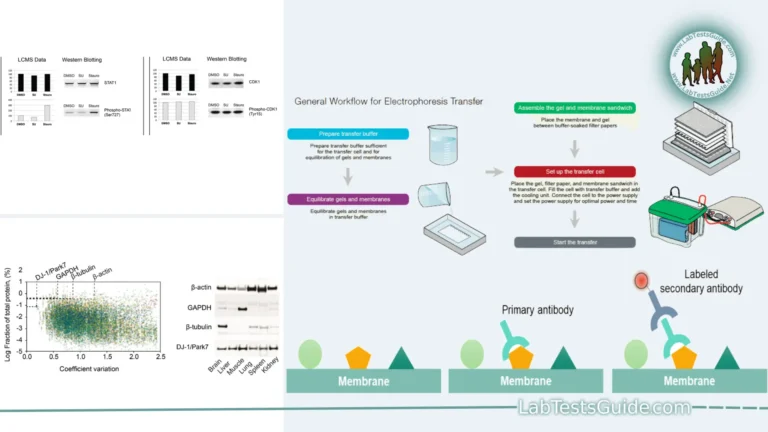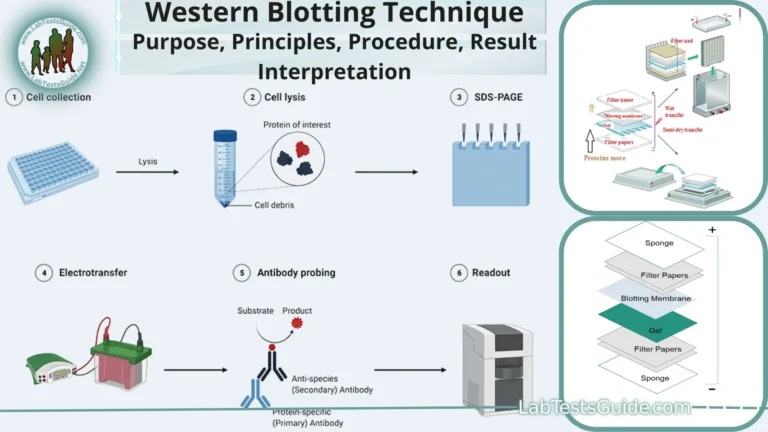Radioimmunoassay (RIA) is a sensitive analytical technique used in clinical laboratories for quantifying antigens, hormones, drugs, and other substances by measuring the binding of specific antibodies to radioactive-labeled antigens or ligands.

Methodology for Radioimmunoassay (RIA) in Clinical Laboratory
Introduction:
Radioimmunoassay (RIA) is a sensitive analytical technique used in clinical laboratories for quantifying antigens, hormones, drugs, and other substances by measuring the binding of specific antibodies to radioactive-labeled antigens or ligands.
Principle:
RIA involves competitive binding between a radioactive-labeled antigen (tracer) and an unlabeled antigen from the sample for a limited number of antibody binding sites. The amount of radioactive signal detected inversely correlates with the concentration of the analyte in the sample.
Specimen Requirements:
- Type of specimen: Serum, plasma, urine, or other body fluids
- Volume of specimen required: Typically 0.1-1 mL
- Collection method: Standard clinical procedures for sample collection (e.g., venipuncture)
- Handling and storage requirements: Store samples at -20°C if not analyzed immediately; avoid repeated freeze-thaw cycles
- Stability of the specimen: Dependent on the analyte; refer to specific stability guidelines
Reagents and Materials:
- Radioactive-labeled antigen (tracer) specific to the analyte
- Antibodies specific to the analyte (primary and secondary)
- Separation reagents (e.g., polyethylene glycol, donkey anti-rabbit IgG)
- Standards with known concentrations of the analyte
- Buffer solutions (e.g., phosphate-buffered saline, Tris-HCl)
- Scintillation fluid and counting tubes
Equipment:
- Gamma counter or scintillation counter
- Centrifuge
- Vortex mixer
- Micropipettes and tips
- Sample racks and tubes
- Refrigerator and freezer (for storage of reagents and samples)
Procedure:
Sample Preparation:
- Prepare the samples by appropriate methods such as dilution or extraction if needed.
- Add a known amount of radioactive-labeled antigen (tracer) to each sample tube. Antibody Binding:
- Add a fixed amount of specific antibodies to each tube containing sample and tracer.
- Incubate the tubes to allow the antibodies to bind to both the tracer and the analyte in the sample. Separation of Bound and Free Antigen:
- Add a separation reagent (e.g., polyethylene glycol) to precipitate the antigen-antibody complexes.
- Centrifuge the tubes to separate the precipitate from the supernatant. Radioactivity Measurement:
- Transfer the supernatant containing free radioactive tracer to counting tubes.
- Add scintillation fluid to the counting tubes and measure the radioactivity using a gamma counter or scintillation counter. Data Analysis:
- Construct a standard curve using the radioactivity counts of standards with known concentrations.
- Calculate the concentration of the analyte in the samples based on the standard curve.
Quality Control:
- Include calibration standards and quality control samples in each assay run.
- Validate the assay performance for accuracy, precision, sensitivity, and specificity.
- Monitor background radiation levels and control for non-specific binding.
Calculation and Interpretation:
- Calculate the concentration of the analyte in the samples based on the radioactivity counts and the standard curve.
- Interpret the results within the clinical context and compare with reference ranges or clinical guidelines.
- Consider potential sources of error, such as interference from cross-reacting substances or incomplete precipitation.
Limitations:
- RIA requires the handling of radioactive materials and adherence to radiation safety protocols.
- Background radiation and non-specific binding can affect assay accuracy.
- The technique may have limited dynamic range compared to non-radioactive immunoassays.
Safety Precautions:
- Handle radioactive materials according to local regulations and institutional protocols.
- Use appropriate shielding and personal protective equipment (PPE) when working with radioactive reagents and samples.
- Dispose of radioactive waste in designated containers and follow radiation safety guidelines.
References:
- Melvin, L. L., & Richardson, G. (1975). Radioimmunoassay. The American Journal of Nursing, 75(12), 2242-2245.
- Tietz Textbook of Clinical Chemistry and Molecular Diagnostics.
- Manufacturer’s instructions for RIA reagents and equipment.
- Clinical Laboratory Standards Institute (CLSI) guidelines for radioimmunoassay methods.
This format provides a structured approach to performing RIA in clinical laboratories, focusing on accurate quantification of analytes using radioactive-labeled tracers and specific antibodies.
Possible References Used







